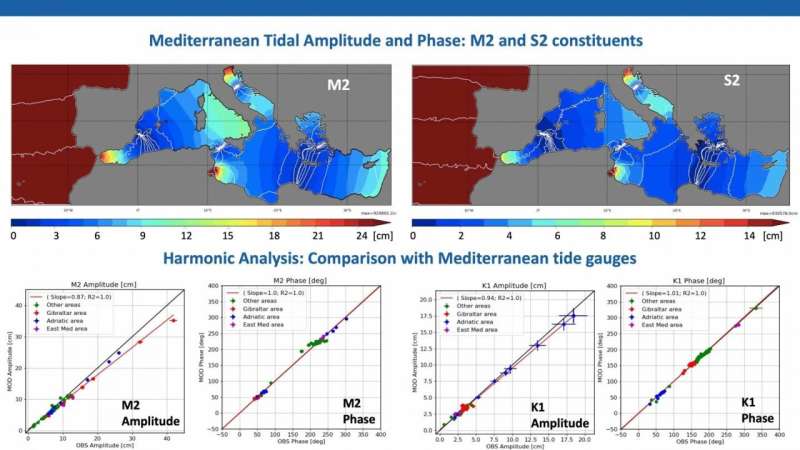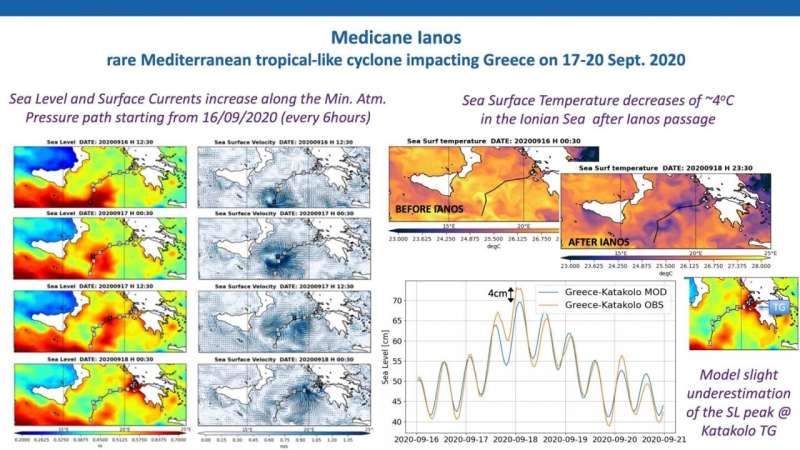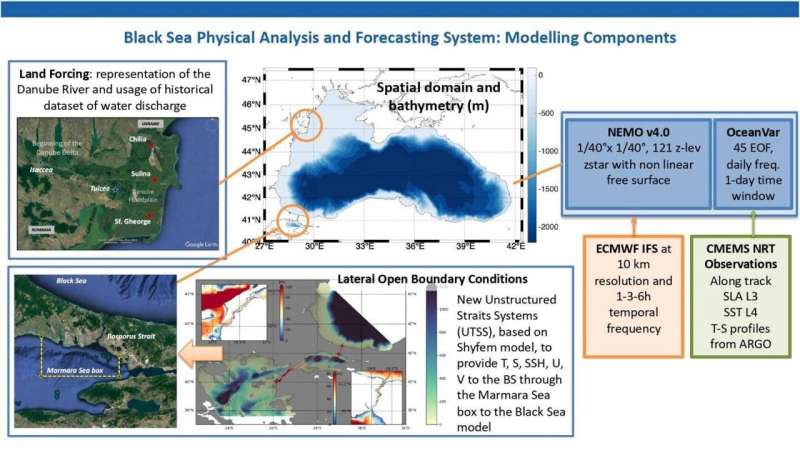Predicting the ocean: Improved forecast and insights for the Mediterranean and Black Seas

Marine forecasters face the challenge of predicting a very complex and constantly changing marine environment by applying ocean science, knowledge and technological skills to produce predictions of the state of the ocean.
Operational forecasts are delivered daily in near real time and rely on numerical model runs to predict how the ocean will change over time and space by means of equations that describe a variety of ocean processes including interactions with waves, atmosphere and land. Ocean forecasts provide predictions of many aspects of the blue ocean, including the ocean temperature, salinity, currents, sea level, tides. Marine observations, both from in-situ and satellite observing systems, are used to produce comprehensive analyses of the ocean used as initial state for the ocean forecast models.
Such information is used to build services and applications for supporting societal activities and Blue Growth in a sustainable way, such as: support safe maritime operations including storm surge and cyclone predictions, search and rescue, navigation, oil spill emergency management; provide regular information to industrial and private sector applications, protection agencies, coastal engineering, fishing and tourism; support the Marine Strategy Framework Directive (MSFD) implementation.
In this framework, CMCC contributes to the Copernicus Marine Environment and Monitoring Service (CMEMS), for the provisioning of regular and systematic information of the blue ocean in the Mediterranean and the Black Seas. It operates with its production units that every day deliver operational ocean products—10-day forecast—for the essential variables, implementing state-of-the-art modeling framework for the hydrodynamics and data assimilation through service and system evolution programs whose objective is to solve physical features of both regional seas for improving accuracy and quality. Moreover, in this context, CMCC ensures the continuous upgrades of the modeling systems for the users' benefit upon the yearly updates of the service catalog.
A recent upgrade of the CMEMS catalog for the Mediterranean and the Black Seas has been performed beginning in May 2021. Realized by a team of researchers at CMCC Foundation, it is the result of a synergic collaboration between CMCC OPA—Ocean Predictions and Applications and ODA—Ocean modeling and Data Assimilation divisions, that cooperate to transfer in operations the results of the applied research in the field of numerical ocean modeling and data assimilation.

The Mediterranean Sea Physics (Med-PHY) is part of the Mediterranean Monitoring and Forecasting Centre (MED-MFC). The upgrade of the Mediterranean Analysis and Forecasting System in May 2021 includes the representation of tidal waves. Despite tides having a limited amplitude in the Mediterranean basin, their interactions with the complex dynamics of the Mediterranean Sea represent a crucial and important challenge to be modeled.
An extensive validation of the new system was carried out and the main results are provided here.
The upgraded modeling system also allowed to improve the representation of extreme events such as the medicane Ianos, a Mediterranean tropical-like cyclone that impacted the Ionian Sea and Greece on 17—20 September 2020. The medicane evolution was clearly captured by the model, by means of increased sea level, surface currents and decreased surface temperature along its path towards the Greek coasts. Moreover, the model was able to capture the ~20 cm sea level increase at the Katakolo tide gauge on the Greek coast, with only a slight underestimation at its peak.
The Black Sea Physics (BS-PHY) is part of the Black Sea Monitoring and Forecasting Centre (BS-MFC). The recent upgrade of the Black Sea Analysis and Forecasting System for the provisioning of Near Real Time products (BS-PHY NRT system) includes many innovative aspects:
- a new spatial domain at about 2.5km in horizontal and higher resolution in the vertical direction: it includes the Bosporus Strait and a portion of the Marmara Sea;
- the implementation of lateral open boundary conditions through the Marmara Sea for better solving the Bosporus Strait dynamics and consequently the Black Sea circulation and physical processes;
- the improved representation of rivers, with a focus to the Danube River, to better represent the peculiarities of the Delta and its role in ruling the physical processes at basin scale;
- the upgrade of the data assimilation scheme to the new high-resolution system for the assimilation of near real time observations—in-situ temperature and salinity profiles, sea level along track satellite data and sea surface temperature from satellite, provided by CMEMS Thematic Assembly Centres (TACs).
The Marmara Sea physically connects the Mediterranean and the Black Sea through the Dardanelles and the Bosporus Straits: from the modeling point of view, its role of optimal interface between the two regional seas has been represented by a novel implementation of a very high resolution model, based on Shyfem, called Unstructured Turkish Strait Systems (UTSS): it provides for the first time monthly climatological lateral open boundary conditions to the Black Sea through the Marmara Sea box (temperature, salinity, sea surface height and velocities). Details about the system and scientific qualifications are here.

Who are the end-users of these forecasts and how do these products help them?
The user-driven nature of this service organization fosters the vision of ensuring the benefit for major users and for key target applications such as: oil spill emergency management, industrial and private sector applications, Marine Strategy Framework Directive (MSFD) implementation, nature based solutions planning, maritime routes optimization, harbor management, and climate trend monitoring.
The Med-PHY NRT product is widely downloaded and is the product with the largest number of users among the regional CMEMS products (more than 150 users during last month). Almost 50% of the users are from the Academic sector, while users from the Public sector and the Business/Private one represent almost 25% each. Data are mostly used for scientific research (more than 50%), but also for training and teaching, commercial use and public service.
At the end of 2020, a number of 40 active users have downloaded BS-PHY NRT products. The area of benefits includes Business/Private companies, Academy and Public Sectors. Applications that use BS-PHY products are mainly used for scientific research and for the Commercial sector, which demonstrates how progressively the market in the Black Sea countries is attracting the Blue Growth initiative.
Such encouraging statistics in the use of both the products are also supported by a very robust service that ensures a minimum number of incidents/failures thanks to a very strict service monitoring and support to Production Units.
More information:
Mediterranean Sea Production Centre
MEDSEA_ANALYSISFORECAST_PHY_006_013, catalogue.marine.copernicus.eu … MED-QUID-006-013.pdf
Provided by CMCC Foundation - Euro-Mediterranean Center on Climate Change



















